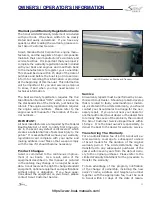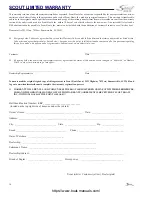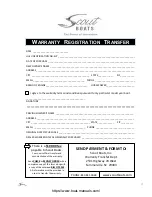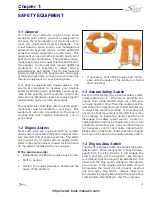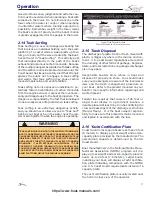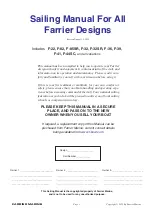
25
OPERATION
2.1 General
Before you start the engines on your Scout, you
should become familiar with the various compo-
nent systems and their operation, and have per-
formed a “Pre-Cruise System Check.” A thorough
understanding of the component systems and
their operation is essential to the proper opera-
tion of the boat. This manual and the associated
manufacturers’ information is provided to enhance
your knowledge of your boat. Please read them
carefully.
Your boat must have the necessary safety equip-
ment on board and be in compliance with the U.S.
Coast Guard, local and state safety regulations.
There should be one Personal Floatation Device
(PFD) for each person. Non-swimmers and small
children should wear PFDs at all times. You should
know and understand the “Rules of the Road” and
have had an experienced operator brief you on the
general operation of your new boat. At least one
other person should be instructed on the proper
operation of the boat in case the operator is sud-
denly incapacitated.
The operator is responsible for his safety and the
safety of all passengers. When boarding or load-
ing the boat, always step onto the boat, never
jump. All passengers should be properly seated
whenever the boat is operated above idle speed.
Your passengers should not be allowed to sit on
the seat backs, gunnels, bows, transoms or on
fishing seats whenever the boat is underway. The
passengers should also be seated to properly bal-
ance the load and must not obstruct the operator’s
view, particularly to the front.
Overloading and improper distribution of weight
can cause the boat to become unstable and are
significant causes of accidents. Know the weight
capacity and horsepower rating of your boat. Do
not overload or overpower your boat.
You should be aware of your limitations and the
limitations of your boat in different situations or
sea conditions. No boat is indestructible, no mat-
ter how well it is constructed. Any boat can be
severely damaged if it is operated in a manner
that exceeds its design limitations. If the ride is
hard on you and your passengers, it is hard on
the boat as well. Always modify the boat speed
in accordance with the sea conditions, boat traffic
and weather conditions.
Remember, it is the operator’s responsibility to
use good common sense and sound judgement in
loading and operating the boat.
2.2 Rules of the Road
As in driving an automobile, there are a few rules
you must know for safe boating operation. The
following information describes the basic naviga-
tion rules and action to be taken by vessels in a
crossing, meeting or overtaking situations while
operating in inland waters. These are basic ex-
amples and not intended to teach all the rules of
navigation. For further information consult the
“Navigation Rules” or contact the Coast Guard,
Coast Guard Auxiliary, Department of Natural Re-
sources, or your local boat club. These organiza-
tions sponsor courses in boat handling, including
rules of the road. We strongly recommend such
courses. Books on this subject are also available
from your local library.
Notice:
Sailboats not under power, paddle boats, ves-
sels unable to maneuver, vessels engaged in
commercial fishing and other vessels without
power have the right of way over motor pow-
ered boats. You must stay clear or pass to
the stern of these vessels. Sailboats under
power are considered motor boats.
Crossing Situations
When two motor boats are crossing, the boat on
the right has the right-of-way. The boat with the
right-of-way should maintain its course and speed.
The other vessels should slow down and permit it
to pass. The boats should sound the appropriate
signals.
Meeting Head-On or Nearly-So Situations
When two motor boats are approaching each other
head-on or nearly head-on, neither boat has the
right-of-way. Both boats should reduce their speed
and turn to the right so as to pass port side to port
side, providing enough clearance for safe passage.
The boats should sound the appropriate signals.
Chapter 2:
https://www.boat-manuals.com/
Summary of Contents for 300 LXF
Page 2: ...2 Rev 0 Print Date 11 7 2016 https www boat manuals com ...
Page 8: ...8 NOTES https www boat manuals com ...
Page 12: ...12 NOTES https www boat manuals com ...
Page 18: ...18 NOTES https www boat manuals com ...
Page 27: ...27 Operation https www boat manuals com ...
Page 40: ...40 NOTES https www boat manuals com ...
Page 60: ...60 NOTES https www boat manuals com ...
Page 86: ...86 NOTES https www boat manuals com ...
Page 98: ...98 NOTES https www boat manuals com ...
Page 122: ...122 NOTES https www boat manuals com ...
Page 130: ...130 NOTES https www boat manuals com ...
Page 155: ...155 MAINTENANCE LOG Appendix C Date Hours Dealer Service Repairs https www boat manuals com ...
Page 156: ...156 Maintenance Log Date Hours Dealer Service Repairs https www boat manuals com ...
Page 157: ...157 Maintenance Log Date Hours Dealer Service Repairs https www boat manuals com ...
Page 158: ...158 Maintenance Log Date Hours Dealer Service Repairs https www boat manuals com ...
Page 159: ...159 Maintenance Log Date Hours Dealer Service Repairs https www boat manuals com ...
Page 160: ...160 Maintenance Log Date Hours Dealer Service Repairs https www boat manuals com ...
Page 161: ...161 Appendix D https www boat manuals com ...
Page 162: ...162 Boating Accident Report https www boat manuals com ...
Page 163: ...163 Boating Accident Report https www boat manuals com ...
Page 164: ...164 NOTES https www boat manuals com ...
Page 166: ...166 NOTES https www boat manuals com ...
Page 172: ...172 https www boat manuals com ...
Page 173: ...173 Scout Boats Inc 2531 Hwy 78 West Summerville SC 29483 https www boat manuals com ...



